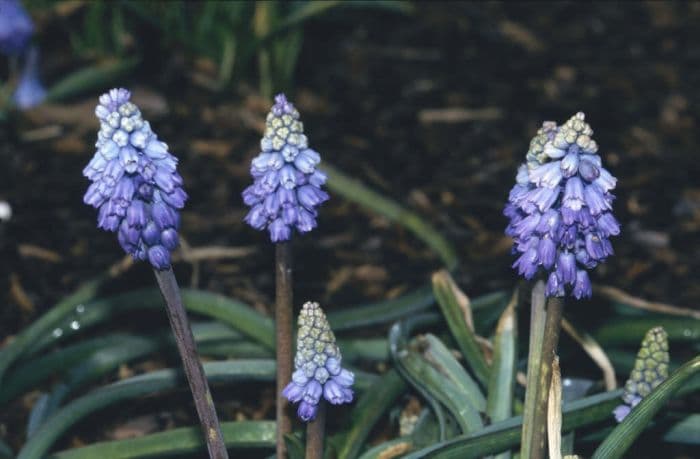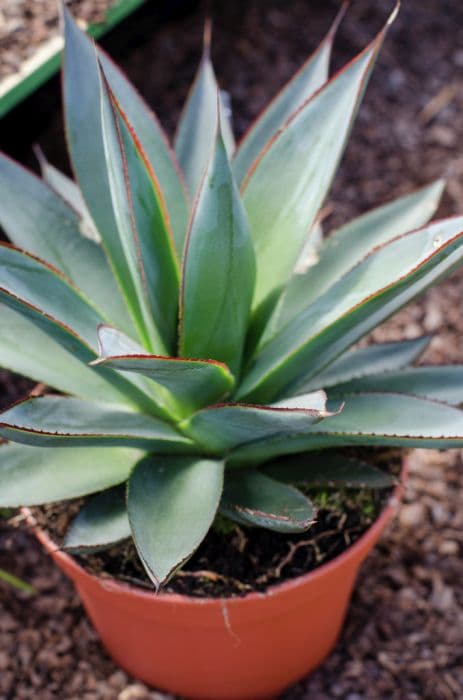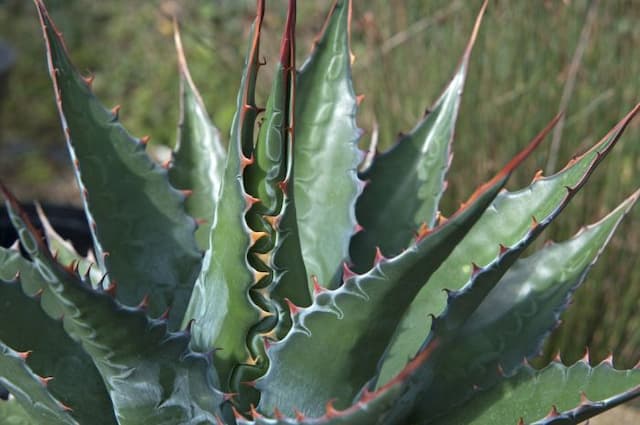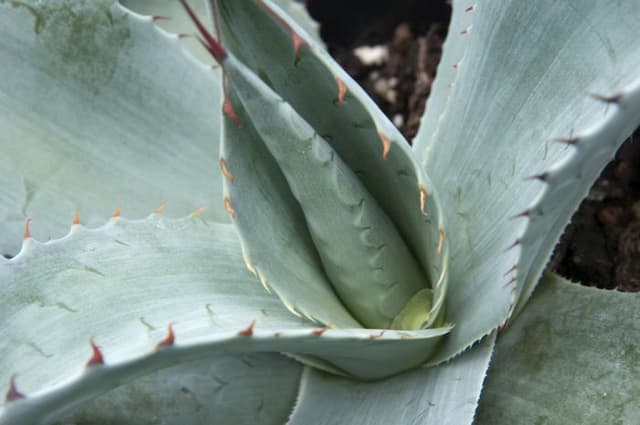Grape Hyacinth Muscari pseudomuscari

ABOUT
The plant commonly known as Grape Hyacinth is a charming and beloved spring bloomer, displaying a distinct appearance that captivates garden enthusiasts. This perennial plant is easily recognized by its dense clusters of small, urn-shaped flowers, which resemble tiny, upside-down grapes. The flowers are most commonly a deep, striking blue, which makes a bold statement against the contrasting lush, green foliage. The leaves of this plant are narrow and strap-like, with a smooth and glossy finish that complements the textural floral spikes. Grape Hyacinth's blooms are tightly packed on the upright stem, which together creates a cylindrical or conical shape, providing a delightful visual impact in the garden. While not described in dimensions, the stature of this plant allows it to form impressive carpets of blue when planted in mass, and yet it is equally enchanting when placed in small clusters within a mixed planting scheme. The plant's overall beauty is not only in its vivid floral coloration but also in its ability to create a sense of warmth and joy in the environment where it thrives.
About this plant
 Names
NamesFamily
Asparagaceae
Synonyms
False Grape Hyacinth, False Muscari
Common names
Hyacinthus muscari, Bellevalia pycnantha, Muscari racemosum, Leopoldia muscari, Pseudomuscari muscari.
 Toxicity
ToxicityTo humans
Grape hyacinth (Muscari pseudomuscari) is generally considered to have low toxicity to humans. However, if ingested, it may cause mild abdominal discomfort, vomiting, and diarrhea. It's advisable to avoid consuming any part of this plant to prevent these unpleasant symptoms.
To pets
Grape hyacinth has low toxicity to pets as well. If a pet ingests part of this plant, they may experience mild gastrointestinal upset, including vomiting and diarrhea. Close observation is recommended, and a veterinary consultation should be sought if symptoms are severe or persist.
 Characteristics
CharacteristicsLife cycle
Perennials
Foliage type
Deciduous
Color of leaves
Green
Flower color
Blue
Height
6 inches (15 cm)
Spread
3 inches (8 cm)
Plant type
Bulb
Hardiness zones
4
Native area
Mediterranean
Benefits
 General Benefits
General Benefits- Aesthetic Appeal: The Muscari pseudomuscari, commonly known as Grape Hyacinth, produces vibrant blue-purple flowers that add a pop of color to gardens and landscapes.
- Easy to Grow: Grape Hyacinths have a reputation for being low-maintenance and easy to cultivate, which makes them suitable for both novice and experienced gardeners.
- Attracts Pollinators: The flowers of the Grape Hyacinth attract bees and other pollinators, supporting local ecosystems and biodiversity.
- Spring Bloomer: Blooming in early spring, Grape Hyacinths provide one of the first splashes of color after winter, signaling the start of the growing season.
- Multiplication: They are known for their ability to naturalize and multiply over the years, spreading to cover larger areas and creating dense floral displays.
- Compatibility: Grape Hyacinths can be planted with a variety of other spring-blooming bulbs and perennials, allowing for creative and complementary garden designs.
- Drought Tolerance: Once established, these plants have good drought tolerance, making them suitable for gardens in areas with occasional water shortages.
- Deer and Rodent Resistant: The Grape Hyacinth is generally resistant to deer and rodents, which helps to prevent damage to the garden by these animals.
 Medical Properties
Medical PropertiesThis plant is not used for medical purposes.
 Air-purifying Qualities
Air-purifying QualitiesThis plant is not specifically known for air purifying qualities.
 Other Uses
Other Uses- Muscari, or grape hyacinth, bulbs can be crushed to make a glue-like substance. This natural adhesive can be used for small crafts or as a sealant for envelopes.
- The sap from grape hyacinth is traditionally used for setting dyes. It acts as a mordant, helping to fix colors to fabrics during the dyeing process.
- Grape hyacinth flowers can be pressed and used in botanical art. Their shape and vivid color make for striking additions to pressed flower compositions.
- The bulb of grape hyacinth can be used in small doses to deter moles and voles in gardens as they dislike the taste and smell.
- When planted in large numbers, grape hyacinth can act as a ground cover, preventing soil erosion in sloped gardens.
- Grape hyacinth is often used in perfumery for its light, floral scent. It adds a spring-like quality to the fragrance blends.
- During the Victorian era, the flowers of grape hyacinth were used to fill miniature vases for elaborate dollhouses.
- The strong, vibrant blue color of grape hyacinth is sometimes utilized in color therapy and meditation gardens to create a calming atmosphere.
- In some cultures, grape hyacinth bulbs are used as part of a natural game for children, who roll them along the ground much like marbles due to their round shape.
- Grape hyacinth flowers can be used as a natural dye source for artworks, providing a range of blue and purplish hues.
Interesting Facts
 Feng Shui
Feng ShuiThe Grape Hyacinth is not used in Feng Shui practice.
 Zodiac Sign Compitability
Zodiac Sign CompitabilityThe Grape Hyacinth is not used in astrology practice.
 Plant Symbolism
Plant Symbolism- Perseverance: Muscari, commonly known as Grape Hyacinth, often symbolizes the ability to endure and continue growing despite challenges, as these plants are hardy and resilient.
- Trust: The sturdy and reliable blooming of Grape Hyacinth can represent trustworthiness and dependability in relationships.
- Hope: The Grape Hyacinth's early spring appearance makes it a symbol of hope and new beginnings, signifying the end of winter and the arrival of warmer days.
 Water
WaterFor Grape Hyacinth (Muscari pseudomuscari), water thoroughly when the top inch of the soil feels dry, typically about once a week. During active growth in spring, ensure they receive approximately one inch of water per week, including rainfall. Be more cautious with watering after they bloom and start to go dormant; overwatering can lead to bulb rot. During their dormancy in summer, watering can be reduced further, and the plants may only need water every two to three weeks if there is no significant rainfall.
 Light
LightGrape Hyacinth thrives in full sun to partial shade. The ideal spot would be where the plant can receive at least four to six hours of sunlight daily, which promotes the best bloom. If positioned in too much shade, the plant might not bloom as vibrantly or prolifically.
 Temperature
TemperatureGrape Hyacinth prefers temperate conditions with an ideal growth temperature ranging between 65°F and 75°F. They can tolerate a minimum temperature down to around 25°F and a maximum temperature of approximately 80°F, but prolonged exposure to extremes can be harmful to the plant.
 Pruning
PruningPrune Grape Hyacinth by deadheading spent flower stalks to encourage bulb vigor, but allow the leaves to remain until they have yellowed and withered. This usually happens by late spring or early summer. Pruning is not often required, but removing the spent flowers prevents the plant from using energy to set seeds, which can benefit the next season's growth.
 Cleaning
CleaningAs needed
 Soil
SoilGrape Hyacinth prefers well-draining soil with a mix of loam and sand or grit, ensuring good drainage. A slightly acidic to neutral pH ranging from 6.0 to 7.0 is suitable for optimal growth.
 Repotting
RepottingGrape Hyacinths generally do not require frequent repotting; do it every 3-4 years or when the bulbs outgrow their container.
 Humidity & Misting
Humidity & MistingGrape Hyacinth is tolerant of a wide range of humidity levels and does not require specific humidity conditions to thrive.
 Suitable locations
Suitable locationsIndoor
Ensure bright light, well-draining soil, and moderate watering.
Outdoor
Plant in well-draining soil, full sun to part shade.
Hardiness zone
4-8 USDA
 Life cycle
Life cycleGrape hyacinth (Muscari pseudomuscari) first emerges as grass-like foliage in early spring, with leaves developing from a subterranean bulb. The plant then sends up a flower spike bearing dense clusters of small, usually blue or purple, urn-shaped flowers that resemble bunches of grapes, hence the name. Following pollination by insects attracted to the blooms, the flowers give way to seed capsules containing black seeds. After flowering, the leaves continue to photosynthesize, replenishing the bulb's energy reserves until they yellow and wither later in the season. The bulb enters a period of dormancy during the summer, remaining underground until the following spring. The cycle recommences the ensuing spring, with a new generation of foliage and blooms emerging once more.
 Propogation
PropogationPropogation time
Spring
The most common method for propagating Grape Hyacinth (Muscari pseudomuscari) is through dividing its bulbs, typically done in the fall after the leaves have died back. This timing coincides with the bulb's dormant period after energy has been stored following the growing season but before the next cycle of growth begins. To propagate, carefully dig up the bulbs and gently separate any offsets, which are small bulbs that grow at the base of a mature bulb. These offsets can be replanted immediately at a depth of approximately 3 to 4 inches (about 7.5 to 10 centimeters) and spaced around 3 inches apart. In the following spring, these newly planted offsets should begin to grow, eventually forming their own clumps that can be divided in subsequent years.









